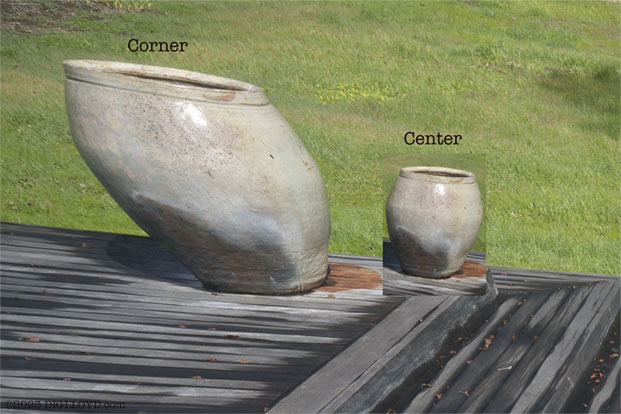Fun Fact: Size of Subject Matter, Center vs Corner
I cannot conceptualize in my head this optical behavior, which of course is fully explained by optical laws. It has something to do with the angle of the lens to the camera and the way the lens is required to project a rectilinear image—I just visualize it to myself without going exploring optical laws.
Below, the same pot is shown as captured in the corner v center. No change in distance, only a change in the way the pot has been included in the picture, the framing of the picture.
Hot tip: the corner is a great spot to put your mother in law for that holiday family photo. Set the lens at 12mm and you’re 'good' so long as you email the photos after everyone goes home.
This effect is why doing stitching with a wide angle lens is problematic, particularly at close range. To compensate, I like to overlap the images much more. But it’s also why I like to use at least a 35mm focal length for panoramas via stitching, with 50mm and 65mm my go-to focal lengths, on up to 105mm or so.

Jason W writes:
Short blog post but this point is a big a deal to me.
As you point out, it makes stitching a pain. Since objects in the corners that are close to the camera are distorted, this changes the scale and weight of them in the composition. It can be hard to visualize all the elements without seeing the final image in the viewfinder, which with stitching, you can't.
Back in the film days, rectilinear ultra wide angle was also a pain. On 6x17, you had optical viewfinders that sat on the top of the camera, but then you had parallax error where you'd have to tilt the frame down to have the same framing as the viewfinder on top of the camera. Many of the viewfinders also had different distortion at wide angles than the shooting lens, so again, more question marks. You could solve all of it by using ground glass, but that sucked on most non-view camera 6x17 models like the Technorama or GX617 because you had to unload the film.
Overall, I feel center cropping a GFX 100S frame and framing using the 65:24 guides is the most effective way to shoot a wide format image.
DIGLLOYD: yep, it’s really difficult, and at close range the true size perspective is also varying hugely over distances of a few feet. Yet your “eye” obeys the perceptual size-distance invariance principle, showing you a non-reality that the camera can never capture because it does not exist. See Perception and Imaging by Richard. D Zakia @AMAZON.
As for really wide format images, it’s a more practical to shoot the Sony FE 12-24mm f/2.8 GM in the 12mm to 16mm range than deal with the Fujfilm GFX100S limits on angle of view (Fujifilm GF 20-35mm f/4).























